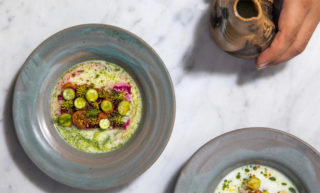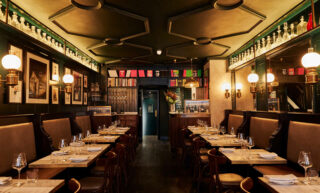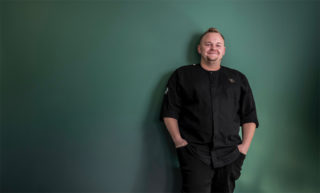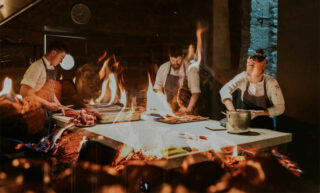Local produce from the German capital in a culinary cave
Nobelhart & Schmutzig’s rigorously regional and seasonal cuisine may not be revolutionary, nevertheless they do an excellent job showcasing the best produce of northeastern Germany. With a large varied wine list, a dose of theatricality and a generous portion of clubbiness, it holds a unique position in the Berlin restaurant scene. No photos, please.
A lightbox in a shop window tells us we are standing in front of restaurant Nobelhart & Schmutzig in Berlin, but the door is closed. Behind the shallow display area, it is boarded up; you can’t look into the restaurant. Outside it is dark and drizzly. For a moment we think we have arrived at the wrong address, but eventually we find a doorbell. “Klingeln bitte”, it says. We press the button and a few seconds later the door swings open. With light drama Billy Wagner, host, owner and sommelier, ushers us in while warning us not to trip over the Wurst, a roll on the doorstep that stops the cold wind from blowing in through the slit under the door. We step into a small, dark reception area, the entrance to Wagner’s cave.
Restaurant Nobelhart & Schmutzig opened five years ago in Berlin’s boho, gritty neighbourhood of Kreuzberg. It immediately received a Michelin star. Entering the list of the world’s 50 best restaurants three years later (now at position 57), it has become a destination restaurant that attracts people from far and wide. If you make the trip, you are rewarded with a ten-course prix-fixe menu that is prepared right in front of you. Except for one large table for groups and a couple of small tables for lovebirds, all guests sit at a counter wrapping around three sides of an open-plan kitchen where waiting and kitchen staff, called “the cast”, perform their act. The tedious work, cutting the vegetables and polishing the glasses, takes place backstage, offside for the diners. With 28 seats, the restaurant is relatively small. Apart from the expected props – stoves, coffee equipment and fridges – the record player takes a prominent position. The cast members double up as deejays in a club, although the decibels are kept in check.
The Cast: Billy Wagner third from the left (photo: Caroline Prange)
Culinary identity
Coming from a small country myself, it is sometimes difficult to explain to a foreigner what is typical for the national cuisine. Most products also grow across the border in neighbouring countries. You think white asparagus are specific for The Netherlands, go to Germany and you’ll know you are not the only one. Same thing with strawberries, Brussels sprouts and herring. Pickling? All over northwestern Europe. So, I was curious to learn from Micha Schäfer, the head chef at Nobelhart, what defines Berlin and the surrounding area of Brandenburg and Mecklenburg-Vorpommern. For him it’s not about presenting a national (or regional) culinary identity. He doesn’t care you can get celeriac and salsify in Poland too. And although Schäfer is clearly inspired by Noma’s Nordic cuisine, he applies it to Berlin, showcasing the best seasonal produce from the best artisanal producers in and around the German capital. Lemon, vanilla, olive oil and other non-native products are scrupulously eschewed. Provenance is key to the menu. The producer of the main ingredient is mentioned below each dish on the menu. And about most of them Wagner or Schäfer has a story to tell. Take Florian Domberger. As a businessman in Asia he missed his German bread. Back in Berlin, he changed career and now provides Nobelhart (and others) with perfect loaves of crusty 100% rye bread. Using minimal ingredients (flour, water, salt) he lets the sourdough do its magic trick.
Schäfer’s dishes never consist of more than two or three minimally cooked, fried, baked, pickled or steamed ingredients. It’s all about the produce, and less about clever, elaborate preparations. And as much as Wagner and Schäfer want to pamper their guests, they also hope you can open up to their idea of good food.
Wagner and Schäfer do not only give their providers a stage, they also try to influence their production process. Lars Odefey, the provider of succulent chicken, is encouraged to breed his own chicks instead of importing them from France. This way Nobelhart & Schmutzig strives to shorten the production chain and control the entire process from farm to table.
Micha Schäfer (Photo: Sara Reuter)
Likewise, on the extensive wine list, only wines typical for their origin are featured. “Don’t expect a cabernet sauvignon from Südburgenland,” Wagner says.
The list is heavy on German wines, but there was no Sekt when we visited. As an aperitif, we settled for a Lambrusco from Vittorio Graziano: rich in dark berries, relatively full-bodied, quite structured but nonetheless refreshing, a good example of Lambrusco’s deserved comeback.
Just as provenance, seasonality and regionality, sustainability is a feature of the restaurant. Nose-to-tail applies as much to meat, as it does to vegetables, although Schäfer says: “Every step should make sense in terms of sustainability, but it is not only about using every part of the animal or a vegetable in one’s own kitchen. The farmer has to play his/her part too, for example by recycling unused parts for the production of humus. Communication with your providers is key. As for the use of meat, we often share an animal with several other restaurants.”
Wagner doesn’t want heavy water bottles to be dragged around. Instead he serves (free of charge) filtered tap water, still and sparkling, thus saving on transportation and reducing the carbon footprint. On the other hand, wines are sourced from all around Europe. Not just natural wines, as you might expect. The selection is a good mix of more traditional (for example Weingut Dr. Loosen’s riesling from Mosel and Elio Altare’s Barolo) and new styles (Weingut Roter Faden’s lemberger from Württemberg and Werlitsch’s Ex Vero II from Südsteiermark), but they all share the quality of being terroir-driven wines. Other types of beverages supplement the choice of wines. A Bavarian black craft beer enhanced the yeasty flavours of our first dessert of roasted malt and rosemary. We also tried the Danish kirsebaer vin, a heady (14% alcohol), intense, barrel-aged cherry wine that was a perfect match with our second dessert of poppy seeds, rosehips and beaten egg whites.
Cave
What remains, besides the memory of thoroughly flavorful dishes and drinks, is Wagner’s eye for detail. From the coffee (the exact amount of ground coffee and water used for one cup is mentioned on the menu) to Wagner’s shabby chique outfit, everything seemed to have been thought through. Least visible, but no less important, is the absence of snapshotting clients. “Berlin has an obsession with privacy. It has a vibrant club scene where things may happen you don’t want to have posted on Instagram. That’s why many clubs don’t allow phones inside,” Wagner explains. “I wanted the restaurant to be a little bit like a Berlin club.” Hence, you can’t look through the windows and into the dark interior.
“In ancient times, people retreated into their caves when they needed a safe place. There you had only the entrance to defend.” Or, as is printed on the menu: “What happens in Nobelhart & Schmutzig stays in Nobelhart & Schmutzig.” But most importantly, your attention goes to where it should go: the regional food, the drinks and your company. No photos, please.
Nobelhart & Schmutzig
Friedrichstraße 218
10969 Berlin-Kreuzberg
Germany
T: +49 30 259 4061-0
E: dubist@nobelhartundschmutzig.com
A Norwegian translation of this article was published in the December 2019 issue (print) of Apéritif magazine.
(Main photo: Caroline Prange)







Comments